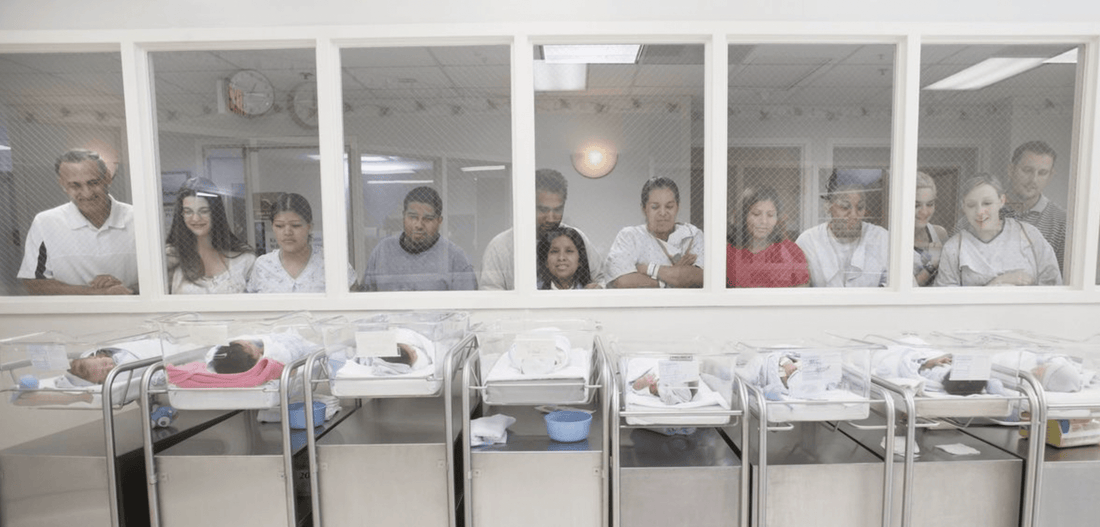My son and his wife recently had a baby boy - my first grandchild! Such a wonder! Both mama and baby are in good health as is daddy, though both parents are a bit sleep deprived at the moment.

It's been thirty years since I had my last baby, and things have changed since then, at least in my city. When I had my babies in the late 80s and early 90s, it felt very progressive to have the father in the delivery room. That certainly wasn't the case for my mother when she gave birth to me in the 60s. Then, my father slept a recliner in the waiting room while my mother was alone with the doctor and nurses, only to be startled awake by a nurse holding a swaddled newborn who announced, "You have a daughter."
When it was my turn to give birth, my husband was in the room witnessing new life with his own blurry eyes. Then he got to go home to sleep, and the kind nurses took my baby to the shared nursery so I could sleep, bringing my child to me every few hours to nurse. Visitors could come to the maternity ward and view all the newborns in their bassinets through a large window, guessing which baby was the one they were there to see.
Not so anymore.
Now the baby goes directly into the hospital room with both parents and stays with them. Dad has a cot to sleep in beside mom's hospital bed, and they're basically on their own, day and night, except for when the nurses pop in. Talk about jumping into the deep end without knowing how to swim! As soon as baby and mom are deemed healthy to go, they are gone. No extended hospital stays to rest up.
My daughter-in-law was in post-op (after a planned c-section) for 2hrs, and the whole time my son and his son were in their room alone together. "I've never been alone with a baby before," he said. Thankfully, he's a quick study. I can see the benefits to this. It's super scary for new parents, intense and intimidating, but it's a case--to stay with the pool analogy--of sink or swim.
The changes over three generations made me wonder what the delivery experience really would've been like for someone in Ginger Gold's time in the 1920s.
Giving birth in the 1920s was a very different experience compared to modern times, both in terms of medical practices and social expectations.
Here's what the internet has to say:
1. Medical Environment
- Home Births Were Common: In the early 1920s, most women still gave birth at home, assisted by a midwife or general practitioner (GP). Hospitals were becoming more common for childbirth, but they were often seen as places for complicated births or emergencies.
- Hospital Births Increasing: By the late 1920s, hospital births were becoming more prevalent, particularly in urban areas, but they were still not the norm for everyone. Hospitals provided more sterile environments and access to trained doctors, but there was also a higher risk of medical intervention, including forceps deliveries, which were sometimes overused.
- Midwives: In rural or working-class areas, midwives were often the primary caregivers for childbirth. They usually lacked formal training, but many had significant practical experience.
2. Pain Relief
- Twilight Sleep: One of the significant developments in childbirth during the 1920s was the introduction of Twilight Sleep, a form of pain relief using a combination of scopolamine and morphine. It didn’t relieve pain completely but made women forget the experience by inducing semi-consciousness. It was popular because it was seen as a way to shield women from the pain and trauma of labor, but it often left women disoriented and unable to fully participate in their delivery.
- Lack of Control: Women under Twilight Sleep often had no memory of giving birth and were sometimes restrained because the drug could make them thrash or become uncooperative. While it promised pain relief, it came with risks like prolonged labor, complications for the baby, or even harm to the mother.
3. Medical Interventions
- Forceps Delivery: Forceps were commonly used during difficult deliveries. Doctors sometimes overused them, especially in hospital births, leading to injuries for both mother and baby. With less understanding of proper use, this tool could be both lifesaving and harmful.
- Caesarean Section: C-sections were rare and often a last resort in the 1920s. They carried significant risk because of less advanced surgical techniques and the lack of antibiotics to prevent infections.
4. Prenatal Care
- Limited Knowledge: Prenatal care was not as systematic as it is today. Women might not have seen a doctor regularly during pregnancy unless complications arose. Advice was often based on folklore, family traditions, or the advice of midwives.
- Nutritional and Lifestyle Recommendations: There was little emphasis on nutrition, though women were often advised to get rest and avoid strenuous activity. Smoking was not widely discouraged during pregnancy, and alcohol consumption was still common.
5. Infant Mortality and Maternal Health
- High Infant Mortality: Despite advances in medicine, infant mortality rates were still high in the 1920s, especially for lower-income families. Infections, complications during delivery, and poor sanitation were significant factors.
- Maternal Mortality: Childbirth was a dangerous time for mothers as well. Without antibiotics, infections such as puerperal fever (postpartum infections) were common causes of death. Hemorrhaging and other complications during delivery were also life-threatening without modern surgical interventions.
6. Social Expectations
- Childbirth Seen as Natural but Private: Childbirth was often considered a natural but private event. Many women had several children during their lifetimes, and pain during labor was seen as a normal part of the process. Discussions about childbirth were often kept within female circles, and there wasn’t much public or medical discourse about improving the childbirth experience.
- Social Pressure on Motherhood: Women were expected to become mothers, and those who didn’t were often stigmatized. There was strong pressure to bear children, and having a large family was seen as a sign of success. For middle- and upper-class women, motherhood was often idealized as a woman’s primary role.
- Birth Control: Although discussions around birth control were becoming more common by the 1920s, it was still controversial and not widely available. The Comstock Laws in the U.S. restricted information on contraception, and many women had limited control over the number of children they bore.
7. Postpartum Care
- Rest and Recovery: After childbirth, women were expected to rest, especially if the birth was difficult or they were part of a wealthier class. A period of confinement at home, typically around a month, was common, during which women recovered and were attended to by midwives or family members.
- Breastfeeding vs. Wet Nursing: Breastfeeding was common, though some wealthier women used wet nurses. By the 1920s, formula feeding was beginning to emerge as an option, but it wasn’t widespread until later in the century.
8. Support Systems
- Family and Community Support: In working-class and rural communities, women often had help from female relatives, neighbors, or local midwives. These women formed the support network during labor, birth, and recovery.
- Professional Medical Help: Access to professional help was more common in cities, where doctors and hospitals were more available. However, many lower-income families still relied on community-based support rather than medical intervention.
Thanks Google! It's pretty clear that the fathers had very little to do when it came to bringing babies into the world and postnatal care.
WHAT DO YOU THINK? PLEASE LET ME KNOW IN THE COMMENTS.
We've come a long way in 100 years. Men and women are more of a team when it comes to parenting, and being a hands on dad is not only the norm (in most cases) but expected.
Ginger experienced the miracle of birth when her daughter Rosa was born. Rosa Reed has her own mystery series as an adult in the 1950s.
Rosa's birth happened in Murder on Mallowan Court.
Available as an ebook, in paperback and in audio.
Rosa Reed's first book is Murder at High Tide.
Available as an ebook, in paperback and in audio.
Don't miss the latest Ginger Gold, Murder at the Cave of Harmony





5 comments
Just wanted to say congratulations on new grand child! Enjoy! Love your books!
Thanks for all this information. I was born in 1945 at home on a farm. All of my 12 siblings were born at home, with the exception of the last two. Back in those days, fathers stayed out in the barns until the delivery was over and Mom and Baby were cleaned up and ready for ‘presentation’, and yes, neighbor women often were the only help for the delivering mother. We are certainly living in a different time, although some young women nowadays have chosen to go back to the home-birthing, and we were blessed with two beautiful granddaughters – now 9 and 4, who entered the world through a family and friends involved homebirth.
Thank you for the update on what is involved in the current baby delivery standards! I am having my first grandchild in about a month and I had no idea.
Congratulations! You and your grandson look great.
This post is very timely. My grandmother just passed away at 100 years and 8 1/2 months! She was born in a hospital in Harlem, NY and lived with her comfortable upper middle class parents in Yonkers. Like Rosa, her parents were older. Her maternal grandmother took care of her. They shared a bedroom and then when her grandmother died, her father’s unmarried sister moved in to help.
I was the youngest of four children and they were born at home whereas I was born in a hospital. My siblings were born in the 1920s and 1930s, and I was born in 1943. My father (a farmer) attended my sibling’s births at home, but when my father took my mother to the hospital for my birth, the doctors and nurses would not allow him to be with my mother; however, my father insisted that he be at my mother’s side and they eventually gave in and allowed him to be there at my birth, which was unusual at that time. I have always admired my father for his persistence and his love for his family.